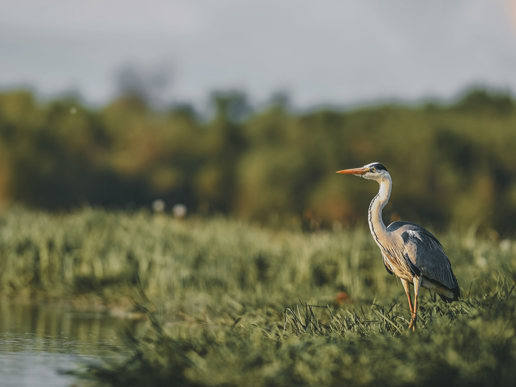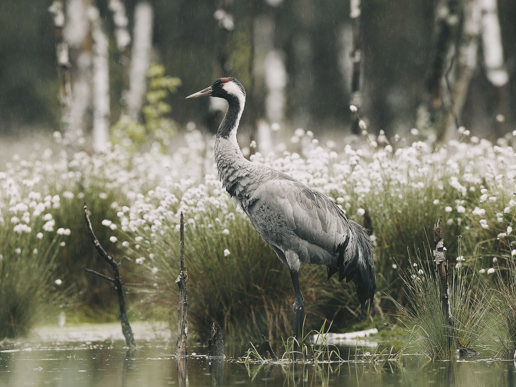We have choices: Reflecting on a back garden ecosystem

Ian Dunn – CEO - Plantlife
So, it’s quite early – 5.54 am to be exact – and I been driven outside into the cool. I’m looking out onto our lawn, half of which has now been cut after Plantlife’s No Mow May, and half of which has been left. The difference in colour palette and appearance is remarkable. One half is low, uniform and largely brown. The other half is above the knee at its maximum height, has flowering heads of the grasses swaying, ever so gently, a deep green and rather thick base of grass and a male robin flitting down to breakfast on whatever insects it is finding.
It has been a very dry and hot period, but not one that is unusual and certainly not different from what we might expect ahead. Let’s revert to the colour of this piece of garden habitat. The grass is brown in the cut area as it is under stress, saving energy and water. It is also brown as the chlorophyll in the leaves breaks down, a process called chlorosis, also part of the energy-saving activity to ensure survival. It is an entirely natural process and the grass in most cases recovers just fine.
Now, let’s delve a little deeper. Most of the plants around us appear green as they are the most amazing solar panels. They absorb almost all the photons in red and blue regions of the light spectrum and 90% of the green. The reflected remaining 10% of the green spectrum is why they appear green to us. By absorbing the sun’s energy so effectively across the light spectrum and combining it with carbon dioxide they are producing oxygen and sugars. It is no exaggeration to say that this most wonderfully simple yet enormously effective mechanism, one that took billions of years to evolve, is the very basis of our life on earth today. Green plants are actively photosynthesising, brown plants are not.
Back to my lawn. The structural diversity of my long grass is in essence allowing the lower parts of the ‘lawn’ to hold more water and is keeping the vegetation close to the soil cooler. The longer areas remain sparkling with water droplets catching the first rays of sunlight; the short cut grass is not quite entirely dry but will be so in no time.
- In effect, the longer, natural grass ecosystem is under far less stress than the cut lawn. It remains productive as the basis for a diverse and thriving habitat not just for a wider range of plants but for invertebrates and birds as well.
This is a blog, not a scientific paper, but I am using this example of my lawn, just a few metres in front of me, to demonstrate that we have choices. We can make a difference to our climate and nature crises through many small actions, as well as the larger ones we also need. We know on a macro scale we can geoengineer some climate solutions but, together, we can far more effectively make the difference we need to by taking multiple small actions which together deliver a societal norm that is far more attuned to the natural world.
As organisations we have our ESG strategies, our CSR approaches, our carbon reduction targets, and all of these are excellent. We can synthesise these approaches down to us all trying to develop an acceptable framework for action, to develop a language and credibility that allows us to act. But let’s not get too ‘hung up’ on what we call it. What we know is that we must, now, take the actions needed to mitigate, adapt and compensate for the climate and biodiversity impacts that, if not addressed, will have deeply negative impacts for societies of humans, animals, plants and fungi around the globe. As an example, we know that when we increase plant diversity – something which is so often dependent on healthy soils and fungi – we will have more resilient ecosystems that will help meet the climate and biodiversity challenges. Therefore, a strategy that enriches the land we manage through increasing its biodiversity should be part of all our ESG approaches and action plans.
My long, plant diverse patch of grassland is still productive, taking carbon dioxide out of the air and locking it in the soil; it is cooler, it is holding water and it is providing a habitat many times richer than my cut lawn. It has made me wonder just why I cut half my lawn; why not a quarter or just enough for the path to the vegetable patch. Next year, I will cut less.
It is self-evident that some areas of land have to be managed for specific purposes. But, let’s challenge the present accepted norms in every way we can; let’s enable a paradigm shift in land management actions that have climate and nature benefits as the first aspect in decision making, not the last.
Finally, if you get the chance this summer to observe the beauty of the early morning sun shining through the exquisitely delicate floret laden heads of grasses swaying in a soft breeze, it will take your breath away (and possibly make you sneeze!). They are stunning. As I finish off this blog, our robin has just flitted down and taken its breakfast on the wing. As it adjusted its body for the final catch, the sun diffused through its outstretched wing feathers in a fleeting moment of extraordinary beauty. That was a pretty good start to the day!
Ian Dunn, CEO, Plantlife is a keynote speaker at Ground Control’s 2023 Green Gains Live event, helping landowners and managers understand why a world rich in plants, fungi is good for nature, climate and us.

Going green is good for business

Business can be the friend, not the enemy, of biodiversity





